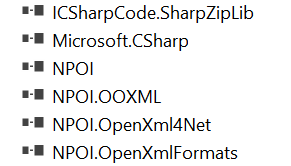接上文:平面文件批量导数据到DB(一),现在继续介绍第二种方法,个人认为第二种和第三种都是不错的方法,第三种需要DB的配合,在下文里面会介绍。
该文主要是介绍使用 NPOI 来处理文件,下面的部分code我参考了 https://www.cnblogs.com/luxiaoxun/p/3374992.html
1、首先需要引用下面的dll

2、Form1.cs 里面的code
using System; using System.Data; using System.Windows.Forms; using NetUtilityLib; namespace WindowsFormsApp3 { public partial class Form1 : Form { public Form1() { InitializeComponent(); } private void button1_Click(object sender, EventArgs e) { string file = @"D:ATSscottzhangDesktopATS工作临时文件 emp eststudent.xlsx"; TestExcelRead(file); } private void WriteDataToDB(DataTable tb) { string connectionString = "server = CSHC7256; uid = sa; pwd = Atser123; database = db_test"; using (System.Data.SqlClient.SqlBulkCopy bcp = new System.Data.SqlClient.SqlBulkCopy(connectionString)) { bcp.SqlRowsCopied += new System.Data.SqlClient.SqlRowsCopiedEventHandler(bcp_SqlRowsCopied); bcp.BatchSize = 100;//每次传输的行数 bcp.NotifyAfter = 100;//进度提示的行数 bcp.DestinationTableName = "[dbo].[student]";//目标表 bcp.WriteToServer(tb); } //进度显示 void bcp_SqlRowsCopied(object sender1, System.Data.SqlClient.SqlRowsCopiedEventArgs e1) { this.Text = e1.RowsCopied.ToString(); this.Update(); } } private void TestExcelRead(string file) { try { using (ExcelHelper excelHelper = new ExcelHelper(file)) { DataTable dt = excelHelper.ExcelToDataTable("student", true); WriteDataToDB(dt); } } catch (Exception ex) { Console.WriteLine("Exception: " + ex.Message); } } } }
3、Class1.cs里面的code
using System; using NPOI.SS.UserModel; using NPOI.XSSF.UserModel; using NPOI.HSSF.UserModel; using System.IO; using System.Data; namespace NetUtilityLib { public class ExcelHelper : IDisposable { private string fileName = null; //文件名 private IWorkbook workbook = null; private FileStream fs = null; private bool disposed; public ExcelHelper(string fileName) { this.fileName = fileName; disposed = false; } /// <summary> /// 将DataTable数据导入到excel中 /// </summary> /// <param name="data">要导入的数据</param> /// <param name="isColumnWritten">DataTable的列名是否要导入</param> /// <param name="sheetName">要导入的excel的sheet的名称</param> /// <returns>导入数据行数(包含列名那一行)</returns> public int DataTableToExcel(DataTable data, string sheetName, bool isColumnWritten) { int i = 0; int j = 0; int count = 0; ISheet sheet = null; fs = new FileStream(fileName, FileMode.OpenOrCreate, FileAccess.ReadWrite); if (fileName.IndexOf(".xlsx") > 0) // 2007版本 workbook = new XSSFWorkbook(); else if (fileName.IndexOf(".xls") > 0) // 2003版本 workbook = new HSSFWorkbook(); try { if (workbook != null) { sheet = workbook.CreateSheet(sheetName); } else { return -1; } if (isColumnWritten == true) //写入DataTable的列名 { IRow row = sheet.CreateRow(0); for (j = 0; j < data.Columns.Count; ++j) { row.CreateCell(j).SetCellValue(data.Columns[j].ColumnName); } count = 1; } else { count = 0; } for (i = 0; i < data.Rows.Count; ++i) { IRow row = sheet.CreateRow(count); for (j = 0; j < data.Columns.Count; ++j) { row.CreateCell(j).SetCellValue(data.Rows[i][j].ToString()); } ++count; } workbook.Write(fs); //写入到excel return count; } catch (Exception ex) { Console.WriteLine("Exception: " + ex.Message); return -1; } } /// <summary> /// 将excel中的数据导入到DataTable中 /// </summary> /// <param name="sheetName">excel工作薄sheet的名称</param> /// <param name="isFirstRowColumn">第一行是否是DataTable的列名</param> /// <returns>返回的DataTable</returns> public DataTable ExcelToDataTable(string sheetName, bool isFirstRowColumn) { ISheet sheet = null; DataTable data = new DataTable(); int startRow = 0; try { fs = new FileStream(fileName, FileMode.Open, FileAccess.Read); if (fileName.IndexOf(".xlsx") > 0) // 2007版本 workbook = new XSSFWorkbook(fs); else if (fileName.IndexOf(".xls") > 0) // 2003版本 workbook = new HSSFWorkbook(fs); if (sheetName != null) { sheet = workbook.GetSheet(sheetName); if (sheet == null) //如果没有找到指定的sheetName对应的sheet,则尝试获取第一个sheet { sheet = workbook.GetSheetAt(0); } } else { sheet = workbook.GetSheetAt(0); } if (sheet != null) { IRow firstRow = sheet.GetRow(0); int cellCount = firstRow.LastCellNum; //一行最后一个cell的编号 即总的列数 if (isFirstRowColumn) { for (int i = firstRow.FirstCellNum; i < cellCount; ++i) { ICell cell = firstRow.GetCell(i); if (cell != null) { string cellValue = cell.StringCellValue; if (cellValue != null) { DataColumn column = new DataColumn(cellValue); data.Columns.Add(column); } } } startRow = sheet.FirstRowNum + 1; } else { startRow = sheet.FirstRowNum; } //最后一列的标号 int rowCount = sheet.LastRowNum; for (int i = startRow; i <= rowCount; ++i) { IRow row = sheet.GetRow(i); if (row == null) continue; //没有数据的行默认是null DataRow dataRow = data.NewRow(); for (int j = row.FirstCellNum; j < cellCount; ++j) { if (row.GetCell(j) != null) //同理,没有数据的单元格都默认是null dataRow[j] = row.GetCell(j).ToString(); } data.Rows.Add(dataRow); } } return data; } catch (Exception ex) { Console.WriteLine("Exception: " + ex.Message); return null; } } public void Dispose() { Dispose(true); GC.SuppressFinalize(this); } protected virtual void Dispose(bool disposing) { if (!this.disposed) { if (disposing) { if (fs != null) fs.Close(); } fs = null; disposed = true; } } } }
个人意见:其实我觉得这个好不错,导资料的速度绝对没问题,但是有个缺点,就是指定了目标表之后没办法指定对应的栏位,只能自己建立一个字段相同的表,再使用这个表过渡到其他表,其实也无大碍,但是我本身不喜欢建那么多多余的表,看起来不是太舒服,关于这一点,大家可以看我的第三篇文章,会介绍另一种方法,可以避免我上面说的那个缺点。